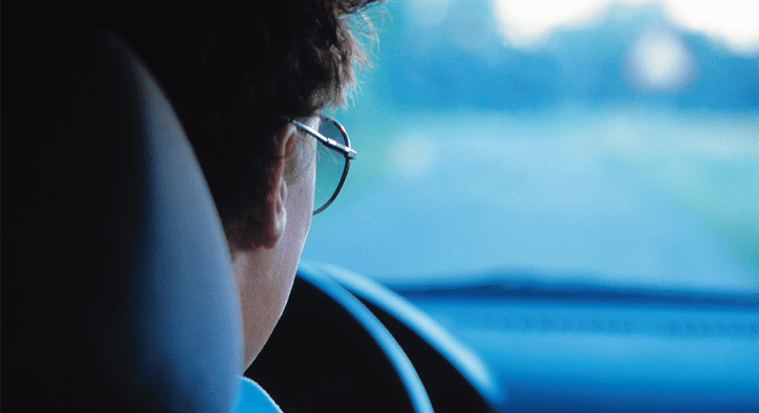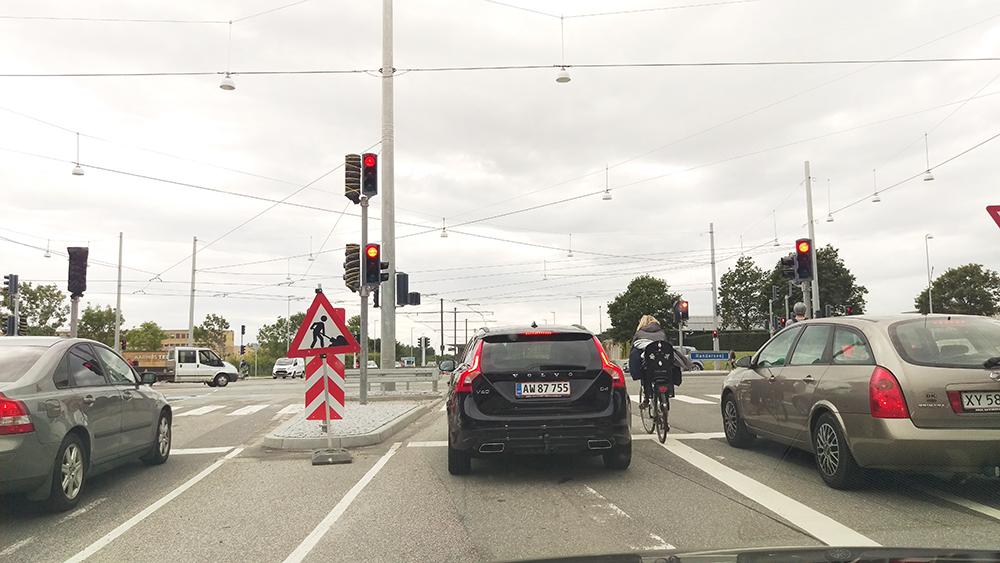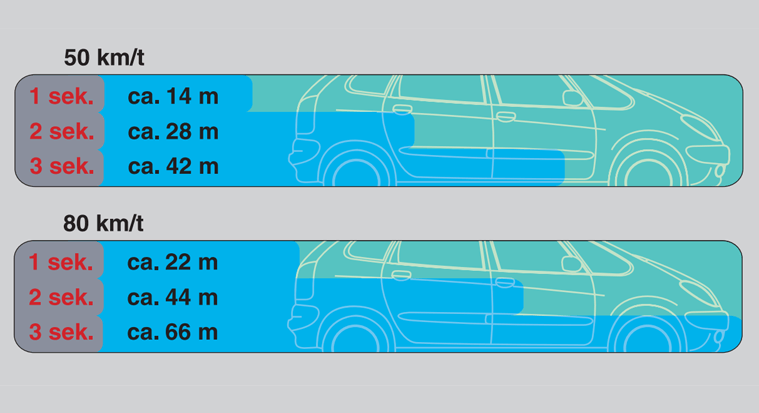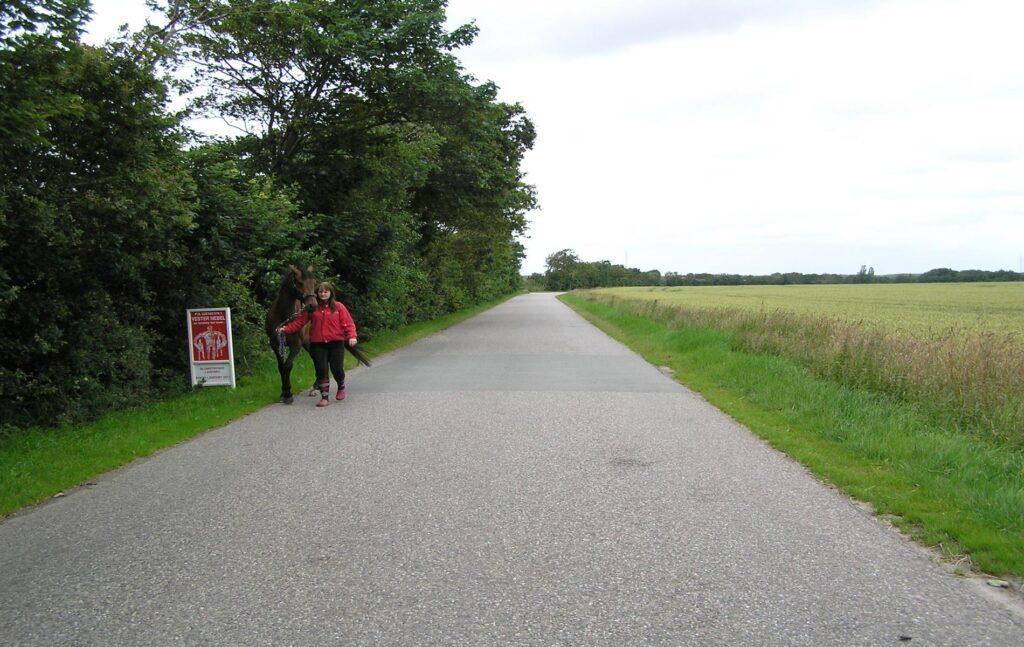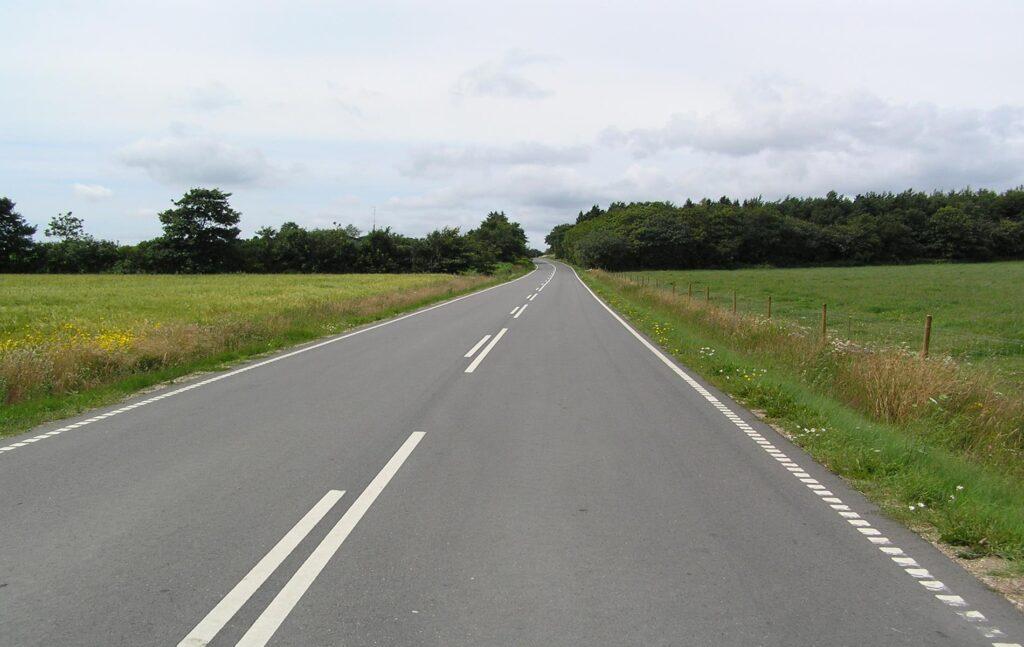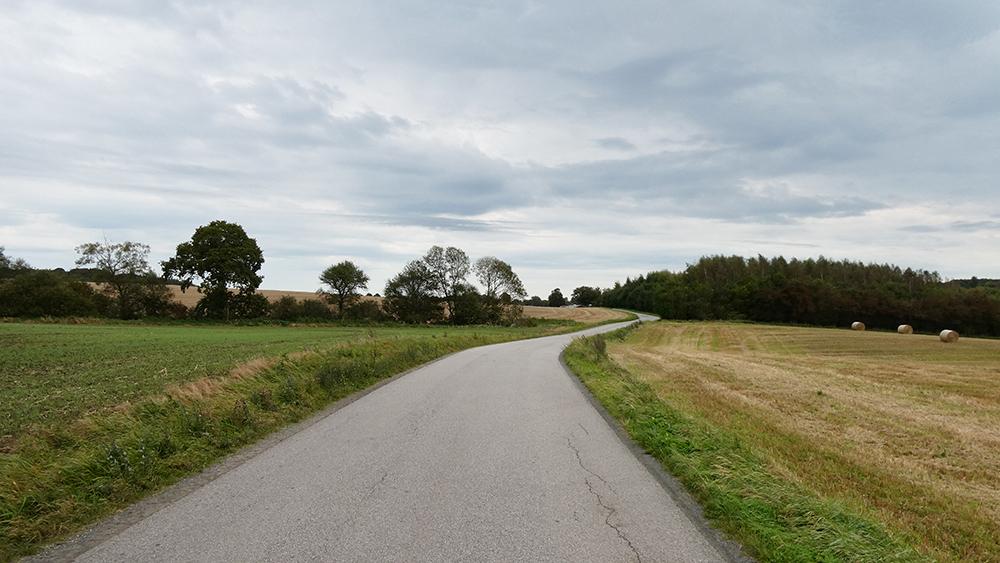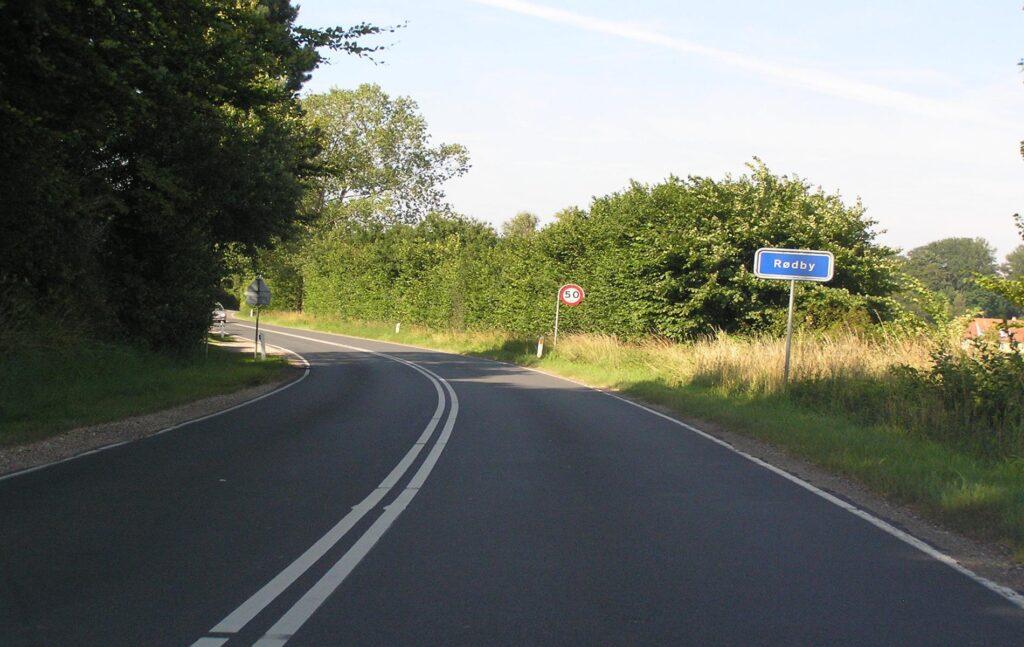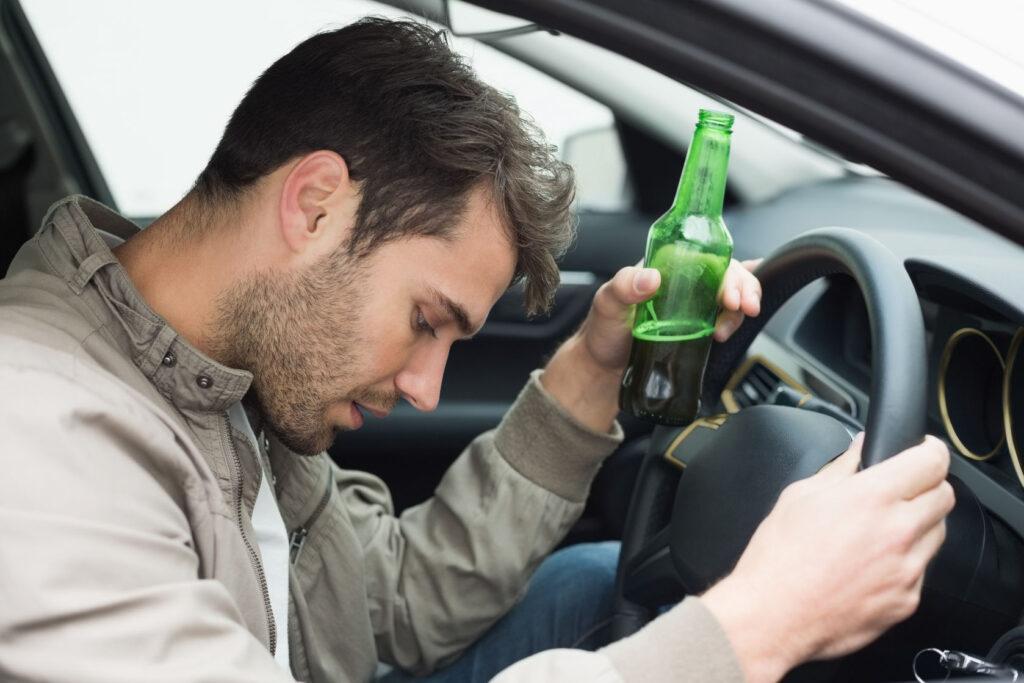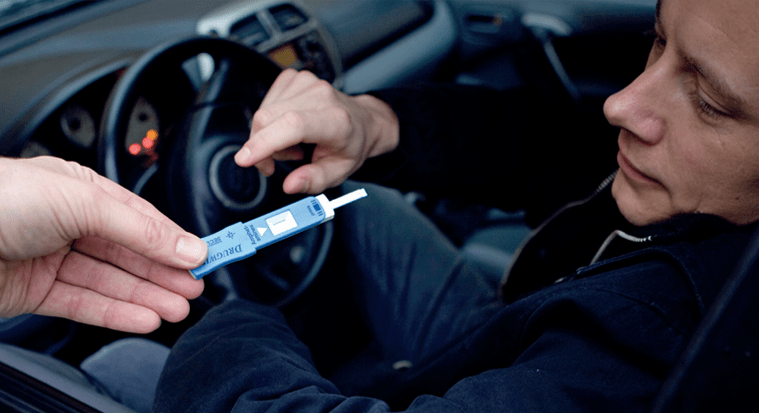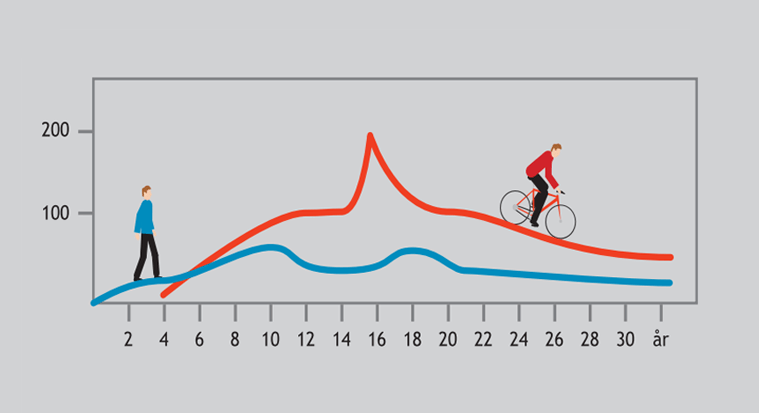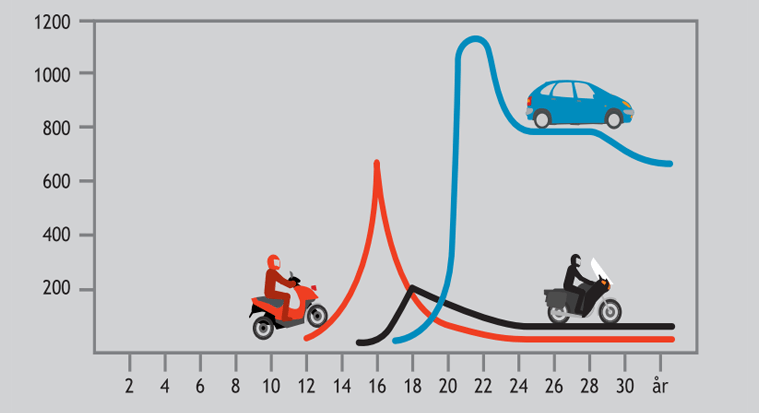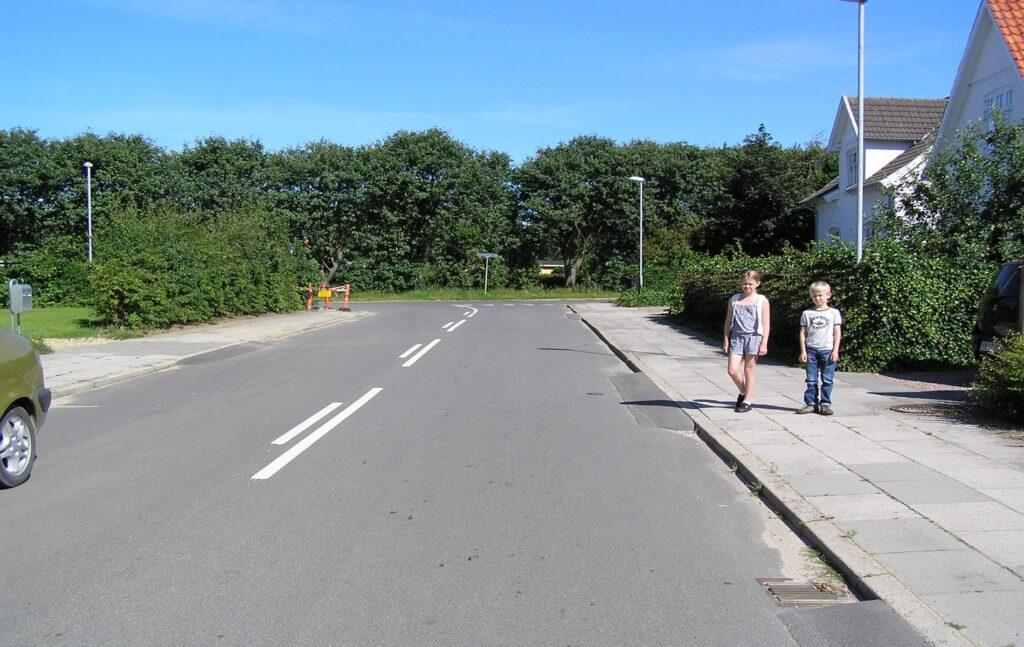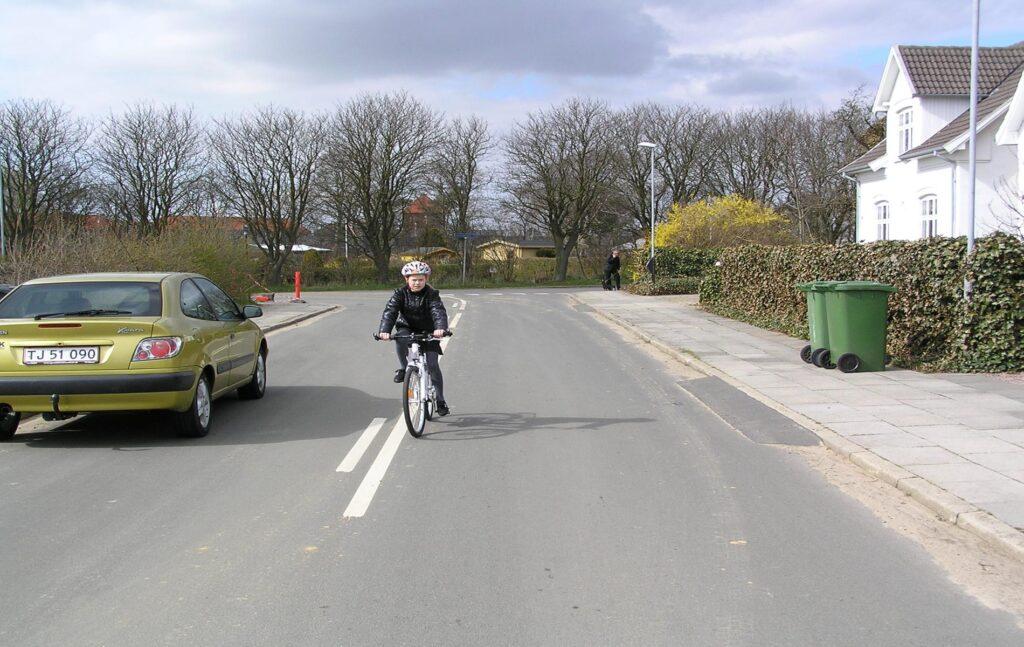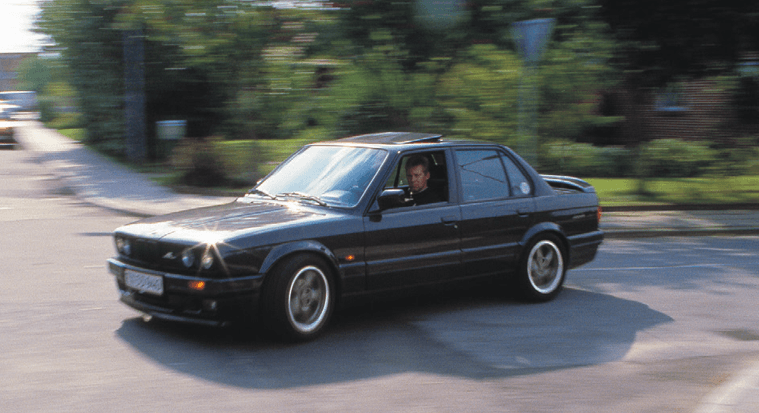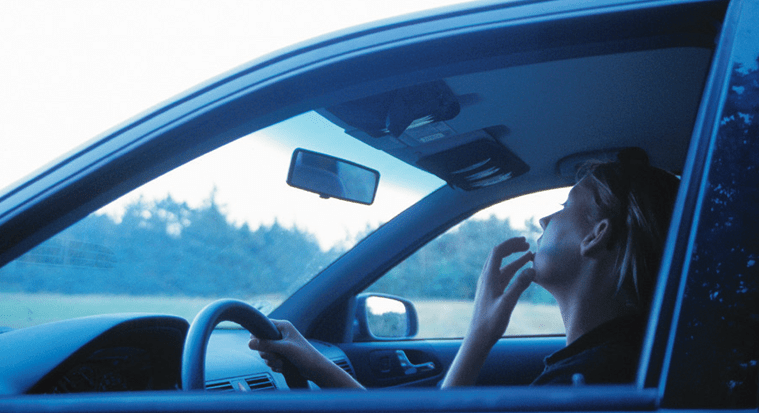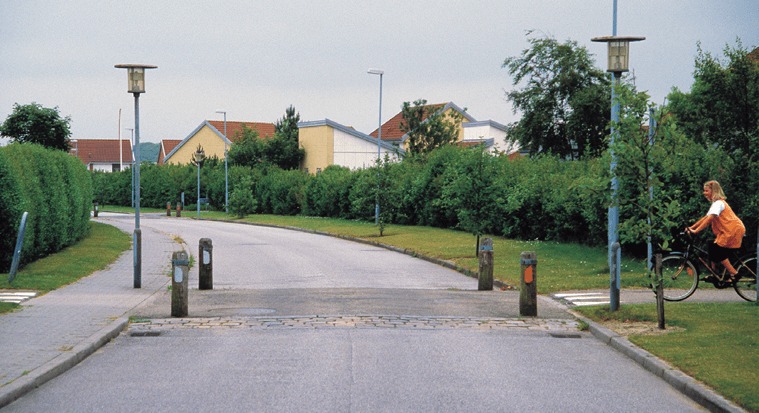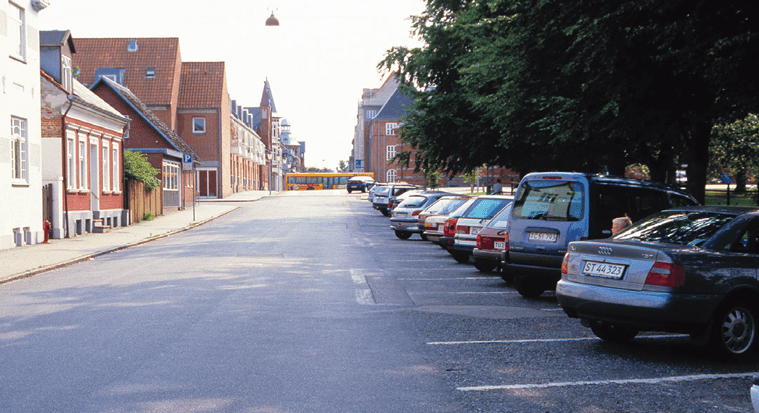car
Driving school
theory book
to category B
Perception and reaction
The vast majority of road accidents are caused by lack of attention, misjudgement of the road situation or irresponsible driving. In other words: Accidents often happen because of human error. Your driving safety does not only depend on how good you are at driving the car from a purely technical point of view. It also depends on how you perceive and judge traffic. And here, like everyone else in traffic, you will have some limitations. You need to know them.
Reaction time
Your reaction time in traffic is the time it takes from when a danger sign appears and is perceivable until you react to it, for example by braking or turning. The reaction time can last from a few split seconds to several seconds, depending on your attention and routine, among other things.
Often the calm, safe reaction is better than the lightning-fast one. It's hard to react calmly and safely when you're a new driver, but it gets easier as you become more experienced.
Perception and reaction skills
Even though you may see every detail in a traffic situation, you may not be able to perceive and react to all of them. At most, you can perceive and react to 2-3 details, danger signs or signals per second. And the faster you drive, the less chance you have of recognising and reacting. Therefore, if you are in a traffic situation with many signals, slow down.
You should also never keep your gaze in one direction for too long at a time, as your visual acuity is limited. To be best orientated, it's a good idea to slowly and slowly let your gaze move slightly at short intervals.
You can actually improve your perception and reaction time a little by simply being aware of the mistakes you're likely to make.
Trust what you see, but also remember that no one can perceive everything perfectly or in the same way.
And always drive in such a way that you have time to stop or take evasive action before an obstacle. In other words, don't just limit your speed, but also drive in a way that keeps you in control of the car at all times.
Mobile phones
Using a mobile phone, talking on the phone or texting will always distract your attention in traffic, increasing your reaction time.
If it's absolutely necessary for you to talk on your mobile phone while driving, use a hands-free kit.
Unfortunately, a hands-free kit is not enough to ensure you are sufficiently attentive to traffic. A call will always reduce your attention to traffic because you have to listen. And it's even worse if the conversation goes badly or if the message is hard to understand or unpleasant.
Avoid talking on a mobile phone in heavy traffic or if you are stressed. It makes you even more inattentive.
When you're inattentive, it's easy to change speed or position yourself incorrectly on the road. That's why it's a good idea to stop the car (where you don't interfere with other traffic) and talk. Or better yet, disconnect the call and call back later!
Distraction
Distraction occurs when you do something that takes your attention away from driving. Typical everyday activities such as finding things in the glove compartment, reading a map, changing a CD, eating an apple or talking to a passenger can distract you from driving. Using electronic devices such as GPS or laptops can also distract you from driving.
Vision and movement
Your vision and your movements are closely linked. Often you will automatically steer in the direction you are looking. This is both an advantage and a disadvantage.
This is an advantage because you can use your gaze to stay on course in a specific direction when driving. When driving on long, open stretches of road, always look as far ahead as possible.
The dependence of your movements on vision can also be a disadvantage. For example, if you look too long at something you need to avoid hitting, you're actually more likely to do so. That's why you should never look too long at oncoming traffic, either when you meet them on the road or at an intersection, but simply orientate yourself and let your gaze fall back on the direction of travel.
Speed and distance judgement
Your own and others' speed and distance is hard to judge.
- Distances under 50 metres are fairly easy to judge. Distances over 50 metres are often overestimated, i.e. they are perceived as longer than they actually are. Your perception of distance depends mainly on your vision and how you perceive the size of things ahead or on the horizon.
- For example, small cars can easily look smaller than they are and actually be closer than you think. The speed of others is fairly easy to judge if the distance is less than 50 metres and the speed is less than about 50 km/h. If they are travelling faster than 50 km/h, you will often judge them to be travelling slower than they actually are. In other words: They are approaching faster than you think. If a car is more than 200 metres away, most people find it very difficult to judge its speed and the distance to it.
- In particular, a large vehicle, such as a lorry, will often appear to be travelling faster than it actually is. And a small vehicle, such as a motorbike, you'll judge it to be travelling slower than it is and further away than it actually is.
- Your perception of your own speed depends, among other things, on how quickly you pass fixed points on the road, such as houses, trees and stripes on the carriageway, and how much the car makes noise and shakes.
- If you're driving on a road with few fixed stops, you're likely to drive faster than you think. The same happens if you're driving a car that doesn't make much noise or has good suspension.
- You can easily underestimate your speed, for example, after coming off a motorway onto a country road where you need to slow down. This is called speed blindness.
Legal regulations on driving ability and health
Alcohol
Even small amounts of beer, wine or spirits can impair your ability to perceive and react, even if your blood alcohol level is low.
If you drive to a place where alcohol is served, you should decide in advance if you want to leave. If you do, avoid drinking alcohol or drink very little.
You must be able to specify the content of the following legal rules:
If your blood alcohol concentration is above 0.50 per mille or above 0.25 mg per litre of breath, you will be punished for drink-driving. If you cannot drive safely, you will be penalised for drunk driving, even if your blood alcohol level is lower.
If your blood alcohol level is above 0.50 and no higher than 2.00 (equivalent to between 0.25 mg per litre of air and 1.00 mg per litre of air), you will be punished with a hefty fine the first time and a prison sentence at higher levels.
If your blood alcohol level is above 0.50 and below 1.20 (equivalent to between 0.25 mg per litre of air and 0.60 mg per litre of air), you will be disqualified from driving conditionally for the first time, and at higher levels you will usually be disqualified unconditionally.
First-time licence holders (i.e. holders of either a motorcycle or car licence who have not yet held their first licence for 3 years) will be banned from driving.
The penalties for drink-driving are significantly increased in repeat offences.
The police can demand breath samples from you at any time.
You must be able to specify the content of the following legal provisions:
It is illegal to drive or even attempt to drive if you have consumed mind-altering substances that are dangerous to road safety.
If you take mind-altering medication contrary to your doctor's prescription, you may be subject to the rules on driving with mind-altering substances in your blood.
If your blood is found to contain mind-altering substances, you will be punished the first time with a fine and unconditional disqualification from driving (equivalent to the penalty for driving with a blood alcohol level of 1.21).
The penalties for driving while impaired are significantly increased in repeat offences.
Narcotics
Taking mind-altering substances (drugs and certain medications) affects your ability to drive and increases the risk of road accidents.
If you consume different narcotics or mix narcotics with alcohol, the effects may be unpredictable, but the risk of an accident will be greatly increased in any case.
Legal regulations on driving ability and health
Alcohol
Even small amounts of beer, wine or spirits can impair your ability to perceive and react, even if your blood alcohol level is low.
If you drive to a place where alcohol is served, you should decide in advance if you want to leave. If you do, avoid drinking alcohol or drink very little.
Illness, medication, fatigue, etc:
The law states that you must not drive or attempt to drive if you are unable to do so safely because you are ill, tired, medicated or under the influence of stimulants or anaesthetics.
Your ability to perceive and react is impaired if you are ill or have been given, for example, nerve or sleeping medication, strong cough or painkillers or medication for allergies, motion sickness, seasickness or the like. The sedative effect of medication is greatly amplified if you consume alcohol at the same time.
Perception and reaction are also affected by both physical and mental fatigue or stress, which is why you should leave the car running if you haven't slept enough or are travelling home after a tiring event. The same applies if you are affected by a mental event, such as a traumatic experience.
Many drivers overestimate their own strength and drive long distances at times when they should be relaxing, resting or sleeping. This is the cause of many accidents.
If a doctor, in an examination requested by the police, determines that you are unable to drive in a fully safe manner, the penalty depends on the degree of impairment (light, moderate, severe or intoxicated). You are penalised in the same way as for drink-driving. You must not leave the car in the care of a person who is unable to drive safely due to illness, fatigue, medication or similar.
Behaviour of other road users
Accidents, age and road user type
Some road users and age groups are more vulnerable in traffic than others. There are particularly high numbers of accidents involving:
- Pedestrians aged 5-10 years.
- Cyclists aged 10-15 years old.
- Moped riders aged 15-19 years old.
- Motorcyclists aged 18-22 years old.
- Drivers aged 18-24 years old.
- Older pedestrians and cyclists from around 70 years of age.
Accidents often occur due to beginner's problems, where the person does not yet have significant experience as a road user. But they can also be due to the fact that as a child or elderly person, for example, you don't react very quickly and are therefore a vulnerable road user.
Age-related difficulties
It is actually possible to say something general about the difficulties and behavioural patterns of different age groups in traffic.
Walking children
Toddlers under the age of about 5 are physically and mentally weak road users, partly because they are not very fast and cannot recognise a potential hazardous situation.
Young children follow sudden impulses, just like they do when playing. They are also less sure-footed and can easily trip or fall. Don't use the horn with children - loud noises can cause them to panic.
Younger schoolchildren aged 6-10 may know the most important traffic rules, but find it difficult to understand that they also need to be careful where others have a duty to stop, for example in a pedestrian crossing.
6-10 year olds find it difficult to concentrate on traffic for long periods of time and may also react to a sudden impulse. Younger schoolchildren take a long time to look around and are slow to recognise traffic situations. They may be able to recognise a clear hazard but not a developing hazard.
Finally, younger school children have even more difficulty judging speed and distance than adults.
Children cycling
Most bicycle accidents happen to children between the ages of 10-15, but many accidents occur as early as 5-6 years old. The reasons for this are similar to those for accidents involving pedestrians and younger schoolchildren. Few children receive sufficient instruction on how to ride a bicycle correctly and safely in traffic, and in addition, they often have problems controlling the bicycle, i.e. keeping their balance, steering and braking. Even older schoolchildren (aged 10-15 years) have difficulty controlling the bike if they have to look in a direction other than the direction of travel and therefore often orientate themselves poorly, especially backwards.
Young people have the best perception and reaction skills, yet they are the ones who cause the most accidents due to inexperience and an uncritical attitude towards traffic and their own driving experience. It proves particularly difficult to judge hazards associated with high speed, own manoeuvrability and other road users.
Young drivers
Some young people use the vehicle to let off steam, test their own abilities or just for the thrill of it. Often they endanger themselves and others without realising it. It's not necessarily because they have indifferent attitudes towards traffic, rules and consideration, but because they can't translate those attitudes into their own driving. Young people's positive attitude often comes into conflict with other road users' lack of consideration and understanding.
Elderly
Older road users often have impaired vision and hearing, resulting in slow perception and reaction. Some older people perceive pedestrian crossings as "safe" places and don't look before crossing. The same is true of a green light at a traffic signal. Seniors who are already nervous in traffic can be startled by loud noises, for example, and this can trigger dangerous panic situations. So avoid using the horn.
Judgement of other road users
There are some characteristics and typical mistakes that you should pay special attention to in other road users, as they can signal to you that you need to be careful.
Characteristics of age, attention and intent
- Age can be indicated by the road user's height, hair growth and colour, posture, way of walking, clothing and, for example, toys or a walking stick.
Attention to detail can be revealed by the road user's head turn, line of sight and any conspicuous objects or conditions to which attention is directed.
– Lack of Attention to other traffic, as evidenced by the road user's actions, e.g. mobile phone use.
– Intent may be evident from the road user's actions, movements or the direction in which the road user is travelling. Here, you often need to look at the current traffic situation as a whole to understand what the road user wants.
Common mistakes made by vulnerable road users
Pay particular attention to these potential hazards:
- The erratic behaviour of toddlers requires you to slow down to a minimum and brake quickly
Children on bikes especially make mistakes when travelling in a straight line, where they don't think about the right of way. The same applies at junctions at left turns or driveways, where they don't orientate themselves properly or don't stop.
- Children on foot may suddenly cross the carriageway. Be careful when encountering walking children at intersections, on residential roads
- And when they travel in packs
- Young drivers especially make mistakes when crossing and turning left
- Elderly pedestrians can be a potential hazard when crossing the road.
One thing to be particularly aware of is the electric scooters, segways and other "vehicles" that users quickly lose control of. One wrong move can lead to loss of control, resulting in a suddenly appearing "vehicle", "driver" or both in your lane.
A child can easily be hidden by cars parked on the side of the road. Some hoverboards and segboards are converted for children to sit in some kind of small carriage.
These go considerably fast and can suddenly come out from behind a parked car and end up on the carriageway.
Own attitudes, behaviour and driving skills
All road users must learn to show positive attitudes and positive behaviour towards their fellow road users and traffic in general, thereby contributing to a considerate and safe traffic flow. It is important that everyone learns defensive driving behaviour in order to minimise the risk of accidents.
Attitudes
You need to be able to state the meaning of the following.
You must:
- Always be positive and helpful, even when other road users make mistakes, and be especially considerate when crossing roadworks.
- Be particularly helpful and considerate of vehicles in emergency situations, as well as understanding of other road users' difficulties (e.g. lack of local knowledge).
- Understand the lack of routine of other road users and the desire of some to move faster than others.
- Understand that others - perhaps especially the elderly - need to exercise caution on the road. Never be influenced/upset by the mistakes or recklessness of others.
- Never be tempted or provoked to take reckless actions.
- Always be forward-thinking and risk-aware.
Behaviour
By the end of the training in section 7. "Manoeuvres on the road" at the latest, you should have mastered the following behavioural skills in practice:
- Show restraint and help other road users, even if they have made mistakes.
- Assist other road users who appear to be having difficulty finding their way, for example by allowing them to change lanes or change position at intersections, even if they are the one in charge.
- Allow plenty of space for large vehicles that need to perform certain manoeuvres such as turning, reversing and the like, even if they are the ones in charge.
- Keep an extra safe distance from drivers who appear unsafe/unfamiliar.
- Drive at a particularly low speed during roadworks, especially where road workers are on the carriageway or in the immediate vicinity, and keep a safe distance from them.
- Keep the road open for emergency vehicles (e.g. on roads with 2 lanes in the same direction of traffic, drivers in lane 1 pull to the right and drivers in lane 2 pull to the left, and at intersections where you stop at a red light, for example, drive slightly forward to the left/right to make room).
- Do not signal (light/sound) to a driver who is a little slow to start at a traffic light, for example.
- Do not signal or give a signal (light/sound) to a driver who pulls in front and reduces the safety distance.
- Do not use abusive words/expressions or gestures towards other road users.
- Always be prepared (e.g. by moving your foot/hand to the brake) if the situation is unclear or uncertain.
Driving skills
Personal factors such as self-control
- but also lifestyle, attitudes, gender, age, self-perception, sense of belonging and the car as the driver's identity influence the driver's choices and behaviour in traffic.
Risk blindness
You need to be familiar with the following:
- Once you've gained some driving experience, you may tend to underestimate the risk in specific situations because things usually go well. You become blind to the risk.
Risk blindness manifests itself in the following:
- Speed selection in poor visibility or poor road conditions where you do not slow down enough to stop before an obstacle. It may therefore be risky to uncritically follow the speed level of other road users in such driving conditions.
- You are driving too close to the car in front of you, so you are unable to stop if the car in front brakes suddenly.
-As a driver, you do things in the car that are not related to the driving task and that cause you to lose focus on driving for too long periods of time.
- You also overlook other risks when you're too tired to drive safely.
Test your knowledge
Cat. B - Sections 4.1 - 4.7
Select the questions you think are the right ones.

